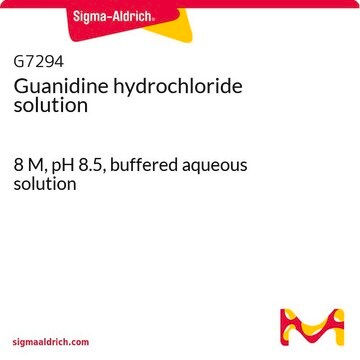G4505
Guanidine hydrochloride
≥99% (titration), organic base and chaeotropic agent
Synonim(y):
Guanidium Chloride, Aminoformamidine hydrochloride, Aminomethanamidine hydrochloride, Guanidinium chloride
About This Item
Polecane produkty
pochodzenie biologiczne
synthetic (organic)
Poziom jakości
Próba
≥99% (titration)
Postać
crystalline powder
metody
RNA extraction: suitable
zanieczyszczenia
≤0.3% water (Karl Fischer)
kolor
white
pH
(25 °C, 4.6 - 6 at 573 g/L)
mp
180-185 °C (lit.)
rozpuszczalność
H2O: 6 M
gęstość
1.3 g/cm3 (lit.)
absorpcja
≤0.10 at 260 nm in H2O at 6 M
ciąg SMILES
Cl[H].NC(N)=N
InChI
1S/CH5N3.ClH/c2-1(3)4;/h(H5,2,3,4);1H
Klucz InChI
PJJJBBJSCAKJQF-UHFFFAOYSA-N
informacje o genach
human ... KCNA1(3736) , KCNA10(3744) , KCNA2(3737) , KCNA3(3738) , KCNA4(3739) , KCNA5(3741) , KCNA6(3742) , KCNA7(3743) , KCNB1(3745) , KCNB2(9312) , KCNC1(3746) , KCNC2(3747) , KCNC3(3748) , KCNC4(3749) , KCND1(3750) , KCND2(3751) , KCND3(3752) , KCNF1(3754) , KCNG1(3755) , KCNG2(26251) , KCNG3(170850) , KCNG4(93107) , KCNH1(3756) , KCNH2(3757) , KCNH3(23416) , KCNH4(23415) , KCNH5(27133) , KCNH6(81033) , KCNH7(90134) , KCNH8(131096) , KCNQ1(3784) , KCNQ2(3785) , KCNQ3(3786) , KCNQ4(9132) , KCNQ5(56479) , KCNS1(3787) , KCNS2(3788) , KCNS3(3790) , KCNV1(27012) , KCNV2(169522)
Szukasz podobnych produktów? Odwiedź Przewodnik dotyczący porównywania produktów
Powiązane kategorie
Opis ogólny
Zastosowanie
- to perform absolute quantitation of amyloid-beta (Aß) isoforms in plasma
- in protein carbonylation assay
- for the quantification of glycosaminoglycans (GAG)
- for denaturation of cow′s milk allergens
- as a control in antiviral screening tests with coxsackievirus B3 (CVB3)
- in RNA isolation to dissociate nucleoproteins and inhibit RNase
Działania biochem./fizjol.
Cechy i korzyści
- Suitable for Biochemical and Cell Biology research
- Ideal for RNA extraction
- High purity product for research applications
Opakowanie
Each kit contains 3 x 100G samples, each sample from a uniquely manufactured lot.
Przestroga
Uwaga dotycząca przygotowania
The maximum solubility of guanidine hydrochloride in water at room temperature is approximately 6M.
Inne uwagi
Informacje prawne
najczęściej kupowane z tym produktem
produkt powiązany
Hasło ostrzegawcze
Warning
Zwroty wskazujące rodzaj zagrożenia
Zwroty wskazujące środki ostrożności
Klasyfikacja zagrożeń
Acute Tox. 4 Inhalation - Acute Tox. 4 Oral - Eye Irrit. 2 - Skin Irrit. 2
Kod klasy składowania
11 - Combustible Solids
Klasa zagrożenia wodnego (WGK)
WGK 1
Temperatura zapłonu (°F)
Not applicable
Temperatura zapłonu (°C)
Not applicable
Środki ochrony indywidualnej
dust mask type N95 (US), Eyeshields, Faceshields, Gloves
Certyfikaty analizy (CoA)
Poszukaj Certyfikaty analizy (CoA), wpisując numer partii/serii produktów. Numery serii i partii można znaleźć na etykiecie produktu po słowach „seria” lub „partia”.
Masz już ten produkt?
Dokumenty związane z niedawno zakupionymi produktami zostały zamieszczone w Bibliotece dokumentów.
Klienci oglądali również te produkty
Nasz zespół naukowców ma doświadczenie we wszystkich obszarach badań, w tym w naukach przyrodniczych, materiałoznawstwie, syntezie chemicznej, chromatografii, analityce i wielu innych dziedzinach.
Skontaktuj się z zespołem ds. pomocy technicznej






